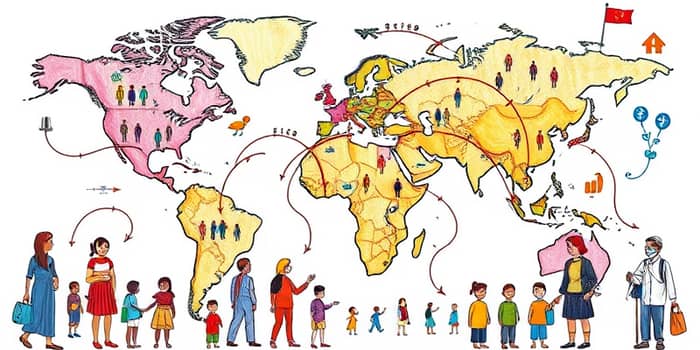The world is on the cusp of a profound demographic transformation. As fertility rates decline and populations age, global markets will undergo fundamental shifts over the 21st century. Understanding these changes is essential for policymakers, businesses, and investors aiming to navigate the emerging landscape.
Global Population Projections and Key Numbers
Today’s global population stands at approximately 8.2 billion (2025 estimates). Demographers project a peak population of around 10.3 billion by the mid-2080s, after which a gradual decline sets in. Annual growth rates are decelerating everywhere, with Europe already experiencing negative growth and Asia expected to follow suit by century’s end.
Regional growth trajectories diverge sharply. Africa will still be expanding—its population rising from 1.55 billion in 2025 to 3.8 billion by 2100—while Asia peaks around 5.3 billion in 2050 before contracting to 4.6 billion by 2100. Europe is set to shrink from 744 million to 592 million, and the Americas will see modest net changes.
Ageing and Fertility Trends
The global median age is set to climb from 31 today to 42 by 2100. The share of people aged 65 and older will more than double—to 24% of the population—while those under 25 will shrink from 40% to 28%. By century’s end, the proportions of youth and elders will reach near parity, compared to the current four-to-one ratio.
Underlying this shift is a persistent drop in fertility. Since the 1960s, global total fertility rates have declined, driven by improved educational opportunities for women, urbanization, and widespread access to contraception. Many advanced economies now record fertility below the replacement level of 2.1 births per woman, catalyzing population shrinkage and accelerated aging in places like Japan and Europe.
Migration and Labor Dynamics
While natural growth slows, substantial net migration flows worldwide will reshape regional demographics. Countries like Germany and the United States rely on immigration to offset domestic population decline, whereas nations such as the Philippines and Venezuela face major outflows. Migration trends foster urbanization, alter labor supply compositions, and reshape consumer demand patterns.
South-South migration (38% of flows) and South-North migration (34%) highlight a complex web of labor movements. In aging societies, targeted migration policies can partially mitigate workforce shortages, sustaining economic activity and demand.
- Migration offsets workforce decline in advanced economies.
- Remittances bolster emerging market consumption.
- Cultural integration influences product and service design.
Economic Implications and Diverging Dividends
The demographic transition presents both risks and opportunities. Emerging economies experiencing rapid workforce growth enter a first demographic dividend window, characterized by a high proportion of working-age individuals, potentially spurring accelerated economic growth.
Conversely, aging societies can realize a second dividend from accumulated savings—if pension funds and private savings are effectively deployed into productive investments. However, this requires prudent fiscal management and strong financial markets.
Sector-Specific Market Transformations
As populations age and shrink, certain sectors will expand dramatically, while others may contract or require reinvention:
- Labor Markets: shrinking workforce in many economies drives wage inflation, automation investments, and remote work solutions.
- Healthcare & Longevity: Demand surges for pharmaceuticals, home care, diagnostics, and senior living facilities.
- Consumer Goods: Tailored products for older adults, from assistive devices to travel and leisure experiences optimized for seniors.
- Education & Childcare Services: Declining youth populations prompt consolidation and innovation in digital learning platforms.
Risks, Challenges, and Opportunities
Policymakers and businesses must navigate a complex terrain of demographic-driven shifts:
- Risks:
- Economic slowdown from declining populations.
- Fiscal strain on pensions and social security systems.
- Widening health and care infrastructure gaps.
- Opportunities:
- unprecedented opportunities for senior markets, including lifestyle, tech, and wellness sectors.
- Emerging markets in Africa and South Asia offer gateway investments in youthful economies.
- Innovations in automation, AI, and robotics to supplement labor shortages.
Conclusion: Navigating a Demographically Transformed Future
Demographic shifts—marked by declining fertility, aging populations, and migration—will fundamentally reshape global markets through the 21st century. Businesses that anticipate changing consumer preferences, invest in longevity technologies, and adapt to new labor dynamics will thrive.
Policymakers must foster inclusive migration strategies, sustain pension systems, and encourage productive investments to harness demographic dividends. By staying informed and agile, stakeholders can turn demographic challenges into engines of sustainable growth and societal well-being.
References
- https://www.pewresearch.org/short-reads/2025/07/09/5-facts-about-how-the-worlds-population-is-expected-to-change-by-2100/
- https://pmc.ncbi.nlm.nih.gov/articles/PMC8393076/
- https://www.ined.fr/en/everything_about_population/data/world-projections/projections-by-continent/
- https://en.wikipedia.org/wiki/Human_population_projections
- https://blogs.worldbank.org/en/opendata/world-population-day--trends-and-demographic-changes
- https://www.visualcapitalist.com/mapped-when-each-country-will-reach-its-population-peak/
- https://www.un.org/en/global-issues/population
- https://www.cbo.gov/publication/61164










